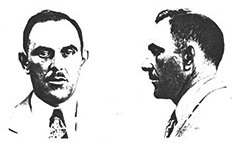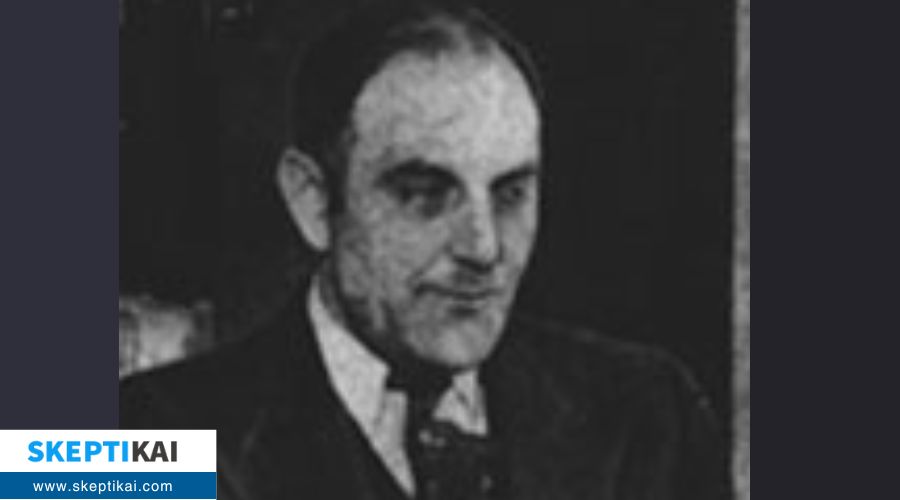In a world where selling bridges is a cliché, Victor Lustig took ambition to new heights by selling the Eiffel Tower not once, but twice. You might think it’s an easy task to spot a scam, yet Lustig’s blend of charm and cunning was so convincing that even seasoned businessmen fell prey to his schemes. As you explore the life of this master manipulator, you’ll uncover the techniques that made him a legend in the underworld of con artists.
But where did his road of deception lead? Let’s just say, all that glitters isn’t gold.
Early Life and Origins

Victor Lustig’s journey into the world of crime began in 1890 in Hostinné, Austria-Hungary, initially surviving as a panhandler and pickpocket. From these humble and illicit beginnings, he honed his craft, developing exceptional card-playing skills that would become a cornerstone of his deceptive practices. Lustig wasn’t just a simple thief; his ambitions and talents grew more sophisticated over time.
You’d find it fascinating how Lustig, despite his early life on the streets, managed to elevate his criminal endeavors. He became infamous for scams like the Romanian money box, a device he claimed could duplicate currency. His ability to deceive others was unmatched, making him a legend among con artists.
Adding to his mystique, Lustig used over four dozen aliases and numerous fake passports, keeping his true identity mysterious and elusive. Even Secret Service agents, who were well-trained in uncovering deceit, described him as charming and incredibly adept at gaining trust. His persuasive demeanor allowed him to weave through society, always staying one step ahead of the law.
Lustig’s early life, marked by panhandling and pickpocketing, laid the foundation for a criminal career that would see him become one of the most elusive figures pursued by authorities.
The Eiffel Tower Scam
Building on his reputation for elaborate schemes, Lustig set his sights on one of Paris’s most iconic landmarks: the Eiffel Tower. In the 1920s, with the tower needing repairs, Lustig saw an opportunity to execute one of the most audacious scams in history. Posing as a Parisian official, he convinced scrap metal merchants that the government planned to sell the tower for dismantling.
Lustig’s plan hinged on a few key elements:
- Forged Documents: He created convincing paperwork that authenticated his authority to sell the tower.
- Luxury Hotel Meetings: By holding discussions in upmarket settings, he added a layer of legitimacy to his claims.
- Bribery: The promise of a lucrative deal led one trader to pay a bribe of $70,000, aiming to secure the purchase.
The culmination of this scam not only resulted in a significant payout for Lustig but also left a trader facing immense embarrassment upon realizing the truth. With every step meticulously planned, from posing as an official to the final act of accepting the bribe, Victor Lustig’s sale of the Eiffel Tower remains one of the most legendary cons in history.
Techniques of Deception
Mastering the art of deception, Lustig’s charismatic presence and well-crafted forgeries were central to his success in conning others. With his charming demeanor, he effortlessly gained the trust of his victims, setting the stage for his elaborate schemes. Lustig’s con artist toolkit was vast, but certain techniques stood out in his legendary scam of selling the Eiffel Tower. Twice.
| Technique | How Lustig Mastered It |
|---|---|
| Forged Documents | Utilizing fake government seals, Lustig authenticated his schemes. |
| Mimicry of Authority | His ability to impersonate authority figures added a layer of legitimacy. |
| Persuasion & Manipulation | Employing manipulation and persuasion, he convinced even the most sophisticated individuals. |
Lustig’s meticulous planning and attention to detail enabled him to execute these complex cons with precision and finesse. His approach wasn’t just about lying; it was about crafting a narrative so compelling that disbelief was suspended. Through this combination of techniques, Lustig didn’t just sell the Eiffel Tower; he sold an experience, a story that was too enticing to question. Thus, he remains one of history’s most audacious con artists, proving that with the right mix of charm, forgery, and manipulation, even the most outrageous lies can become momentarily true.
Other Notable Scams
While selling the Eiffel Tower stands as Lustig’s most audacious scam, his repertoire of deceit didn’t stop there. You’d find his con artistry extended well beyond this famed exploit, marking him as one of the most versatile fraudsters of his time. His notable scams include:
- Swindling Al Capone: Lustig managed to con Al Capone, one of the most feared gangsters, in a get-rich-quick scheme that showcased his daring and cunning.
- Large-scale counterfeiting in the 1930s: He ran a successful counterfeiting operation, flooding New York with fake currency, demonstrating his ability to orchestrate complex scams.
- Arrest and sentence to Alcatraz: His counterfeit escapades culminated in his 1935 arrest in New York, leading to a 20-year sentence in the notorious Alcatraz prison.
Despite his eventual capture and death in 1947 from pneumonia, Lustig’s life as a con artist was marked by an array of successful frauds. Interestingly, even in death, his penchant for deceit was evident, as his death certificate labeled him an ‘apprentice salesman’, a modest title for a man of his notorious caliber.
The Rumanian Box
Among Victor Lustig’s ingenious schemes, the Rumanian Box scam stands out for its creativity in duping individuals into believing they could effortlessly duplicate their money. This fraudulent device, crafted by the man who twice sold the Eiffel Tower, was marketed as a miraculous machine capable of duplicating banknotes. With the Rumanian Box, Lustig managed to deceive people into handing over their genuine currency in the hope of creating endless wealth.
One of Lustig’s most notable victims of this scam was a Texas sheriff, whom he tricked into believing in the box’s magical abilities. The sheriff, like many others, was drawn in by the allure of multiplying his money without any effort, only to find out he had been swindled.
Here’s a brief look at the Rumanian Box scam:
| Aspect | Details |
|---|---|
| Creator | Victor Lustig |
| Nature of Device | Fraudulent device designed to deceive |
| Marketing Promise | Capability to duplicate banknotes |
| Notable Victim | Texas sheriff tricked into believing in its efficacy |
Lustig’s Rumanian Box remains one of his most successful cons, showcasing his unparalleled ability to exploit human greed and gullibility.
Capture and Imprisonment
Victor Lustig’s reign of deception came to an end in 1935 when FBI agents G. K. Firestone and Fred Gruber finally nabbed him. After years of eluding capture, his storied career of fraudulent schemes had caught up with him, leading to his arrest. The infamous con artist, known for selling the Eiffel Tower twice, faced the reality of his actions as legal consequences loomed large.
Lustig was sentenced to twenty years in jail, a testament to the gravity of his crimes. Despite the seemingly secure confines of the detention center in Manhattan, he attempted an audacious escape using bed sheets. His brief taste of freedom led to:
- A dramatic car chase.
- His recapture in Pittsburgh.
- Further solidification of his notorious legacy.
Even in custody, Lustig’s cunning was evident, but his escape attempt only added to his legal woes. Recaptured, he was thrust back into imprisonment, his earlier escapades now a distant memory. The consequences of his fraudulent schemes had finally caught up with him, ensuring that his days of deception were firmly behind bars.
Lustig’s Legacy
Lustig’s legacy, marked by his audacious sale of the Eiffel Tower not once but twice, cements him as a mastermind in the annals of con artistry. You’d be hard-pressed to find another con artist quite like Victor Lustig. His ability to pull off the unthinkable, not just with the Eiffel Tower but through numerous other scams, showcases a level of deception that’s both appalling and awe-inspiring.
As one of the early 20th century’s most notorious figures, Lustig’s life and the sheer audacity of his cons have fascinated scholars and criminal enthusiasts alike. You learn from his tale that anyone, regardless of their sophistication or savvy, can fall victim to a well-crafted fraud.
Yet, it’s not just the thrill of the con that defines Lustig’s legacy. It’s also a cautionary tale, reminding you of the allure and consequences of engaging in deception. His elaborate schemes, particularly the Eiffel Tower sales, underscore the lengths to which he’d go to deceive and profit.
The Ten Commandments of Con
Delving into the core of his craft, we find that Lustig’s ‘Ten Commandments of Con’ served as a meticulous blueprint for manipulating targets with remarkable efficacy. These commandments weren’t just rules; they were an art form, refined by Lustig to ensure he could charm, deceive, and gain the trust of his marks with unparalleled skill. By adhering to these principles, Lustig elevated himself to legendary status among con artists, leaving a legacy that continues to fascinate those studying manipulation, trust, and deception.
The Ten Commandments of Con underscored several critical traits for successful cons:
- Patience, to wait for the perfect moment.
- Agreement, to make the target feel understood.
- Hints at sex talk, to distract and engage.
These guidelines weren’t merely suggestions but essential strategies for any con artist looking to execute scams with the finesse that Lustig did. His ability to employ charm, create elaborate frauds, and manipulate situations to his advantage was a testament to his deep understanding of human psychology. Lustig’s commandments are a reminder of how trust and deception can be intricately woven together by those who master the art of the con.
Conclusion
You’ve ventured through the captivating tale of Victor Lustig, a master of deceit who sold the Eiffel Tower not once, but twice. His journey from humble beginnings to becoming a legendary con artist showcases the dark allure of quick riches through cunning.
Despite his ingenious scams, Lustig’s greed led to his downfall. Let his story be a stark reminder: the pursuit of wealth through deception is a perilous path that often ends in ruin.



